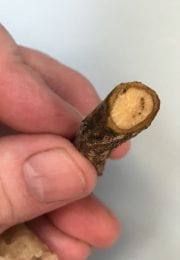By Judy O’Mara
Declining Oaks...are not that easy to sort out. There is an assumption that if an oak tree is dying it must be due to a disease. That is usually NOT the case. Most of the poor growth that we see on oak trees in Kansas is generally due to a combination of site factors and environmental extremes. 2018 and 2019 provide back to back examples of weather extremes. Add in site factors like tree planting depth (too deep), construction damage, heavy soils or compacted soils that drain poorly, sandy soils that don’t hold on to water very well, and trees can develop root systems that are not as vigorous as they should be. The result is a situation where trees are prone to declining under weather extremes – and Kansas is all about extreme weather.
A look at some weather data for Johnson County (Olathe, KS) provided by the K-State Weather Mesonet shows that the 20yr average annual precipitation is 40.04” for that location. At a glance it is easy to see that some years run wetter than average and some years are drier than average. I picked the Johnson County, KS location to highlight because we frequently get oak tree samples in the K-State Plant Disease Diagnostic Lab from the Kansas City area with questions about disease.
2018 was a dry year due to a winter drought and we saw trees decline across the state, including quite a few oaks from the Kansas City area. There was below average precipitation between November 2017 and September 2018. This weather snapshot also shows extreme weather during 2019, particularly during April and May. Saturated soils resulting in root damage and tree decline has been a common problem this year. Young trees and shrubs are particularly at risk due to smaller root systems. In many cases, damage wasn’t immediately apparent until June or July when higher temperatures put a greater demand on the root system. So bottom line, extreme weather patterns frequently play a role in the health of our landscapes.

That said (most oak problems are not due to disease), we have picked up two different oak diseases in the Kansas City area this summer that have the potential to cause tree decline, Hypoxylon canker and oak wilt.

Hypoxylon canker, also known as Biscogniauxia canker (Biscogniauxia atropunctata; B. mediterranea) is a disease common on oak trees throughout Kansas. It is considered to be a stress disease, usually associated with drought stress. Trees showing symptoms in 2019 were likely triggered by the dry growing conditions of 2018.
The initial symptoms of Hypoxylon canker are a tan or silver fungal mat on the trunk of the tree. This light colored surface layer quickly wears off and exposes a black crusty mass that looks like asphalt. Leaves turn yellow and shed and infected trees generally die within the first year. By the second year the dead oaks slough off the remainder of their bark. The best protection against Hypoxylon canker is to avoid stress. This starts with planting into well-drained sites and providing deep, regular watering during prolonged periods of dry weather. Also take care to avoid damage due to construction activities.

Oak wilt (Bretziella fagacearum) has been picked up in a couple of red oak trees in the Kansas city area (Johnson County, KS) this summer. It is an occasional problem on red oaks and pin oaks in northeast Kansas and in counties along the Missouri state line.
Oak wilt causes a partial leaf scorch (brown at the leaf tip and green at the base). Beneath the bark tissue, the disease produces dark brown streaks in the sapwood (see photos). Oak wilt on red oaks tends to start on a major limb or in a section of a tree and then progress until the tree dies, usually within a season.
The disease can be spread by sap feeding insects so it is important to avoid pruning oaks between April-June. Oak wilt can also spread to nearby red oak trees through roots that have fused.
There is no cure for the disease. Infected trees should be removed and destroyed. The wood should not be kept for firewood. If there are red oaks nearby, the root grafts between the trees should be severed. Healthy red oaks nearby may benefit from a fungicide injection.
 The best time to test for oak wilt is when trees are freshly wilted, generally in the spring.
The best time to test for oak wilt is when trees are freshly wilted, generally in the spring.

More information on oak wilt can be found at the K-State Horticulture Information Center. Link is listed below:
Common Oak Diseases in KS
- Hypoxylon Canker
- Bot Canker
Less common oak diseases in KS
- Tubakia leaf spot
- Bur oak blight
- Oak wilt
Odd but interesting oak problems in KS
- Oak galls
- Obscure scale, Lecanium scale
- Oak tatters
